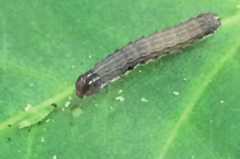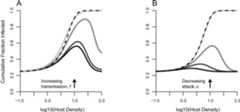- Corpus ID: 3905739
LSU Digital Commons LSU Digital Commons Cannibalism and infectious disease: Friends or foes? Cannibalism and infectious disease: Friends or foes?
@inproceedings{LSUDC, title={LSU Digital Commons LSU Digital Commons Cannibalism and infectious disease: Friends or foes? Cannibalism and infectious disease: Friends or foes?}, author={}, url={https://api.semanticscholar.org/CorpusID:3905739}}- Biology, Environmental Science, Medicine
The interaction between cannibalism and parasites is examined and advances across independent lines of research suggest that cannibalism may also limit disease, and examples from a synthesis of the literature are presented showing how cannibalism may also limit disease.
No Paper Link Available
30 Citations
30 Citations
Viral transmission and infection prevalence in a cannibalistic host–pathogen system
- Benjamin G. Van AllenForrest P. DillemuthVanja M. DukicB. Elderd
- 2023
Biology, Environmental Science
Using an insect pest, the fall armyworm, that readily cannibalizes at the larval stage and its lethal pathogen, it is shown that cannibalism can decrease infection prevalence and, therefore, may not be as deleterious as once thought.
Disease, contagious cannibalism, and associated population crash in an omnivorous bug, Geocoris pallens
- J. RosenheimN. A. BoosterA. Sadeh
- 2019
Environmental Science, Biology
California populations of the omnivorous predatory bug Geocoris pallens are subject to infection by a pathogen that elicits elevated expression of cannibalism, and population crashes appear to reflect the combined consequences of direct virulence—adverse pathogen effects on the infected host’s physiology—and indirect virulence-mortality of both infected and uninfected individuals due to elevated cannibalism expression by infected individuals.
Cannibalism and competition can increase parasite abundance for parasites with complex life history strategies.
- Sarah R. GoodnightMichael W McCoy
- 2024
Environmental Science, Biology
There are multiple mechanisms through which high cannibalism environments can benefit parasites that use paratenic hosts and trophic transfer to complete their life cycles, and indirect competitive interactions between parasites that can also increase infections at small scales are found.
Cannibalistic necrophagy in red foxes: do the nutritional benefits offset the potential costs of disease transmission?
- P. Oliva‐VidalJ. TobajasA. Margalida
- 2021
Environmental Science, Biology
Observations of cannibalistic necrophagy in red foxes provide direct evidence against the parasite-avoidance hypothesis, suggesting that carnivore and conspecific carcasses can represent an alternative trophic resource for foxes in certain areas and circumstances.
Resource competition explains rare cannibalism in the wild in livebearing fishes
- R. RieschM. S. AraújoR. Langerhans
- 2022
Environmental Science, Biology
It is suggested that cannibalism in livebearing fishes is rare in the wild because preying on conspecifics is energetically costly and only becomes worth the effort when competition for other food is intense, and due to the artificially reduced cost of capturing conspecials within confined spaces, cannibalisms in captive settings can be much more frequent.
Behavior and developmental consequences of cannibalism in Spodoptera frugiperda
- Shangchao ZhouShengbo LiXialin ZhengXiaoyun WangWen Lu
- 2024
Biology, Agricultural and Food Sciences
Overall, consuming a small quantity of conspecifics in addition to maize leaves prolonged the developmental duration of larvae and pupae to some extent, increased the body weight, and did not impact the longevity or reproduction of S. frugiperda, however, cannibalism only, without access to maize leaves, had a detrimental effect on adult longevity and reproduction.
Smart carnivores think twice: Red fox delays scavenging on conspecific carcasses to reduce parasite risk
- M. GonzálvezC. Martínez-CarrascoJ. A. Sánchez‐ZapataM. Moléon
- 2021
Environmental Science, Biology
Pathways to the density-dependent expression of cannibalism, and consequences for regulated population dynamics.
- J. RosenheimS. Schreiber
- 2022
Environmental Science, Biology
A rich diversity of pathways through which rising density elicits increased cannibalism are revealed, including both factors that elevate the rate of dangerous encounters between conspecifics and enhance the likelihood that such encounters will lead to successful cannibalistic attacks.
Do scavengers prevent or promote disease transmission? The effect of invertebrate scavenging on Ranavirus transmission
- Mitchell Le SageBailey D. ToweyJ. Brunner
- 2019
Environmental Science, Biology
It was found that removal of infectious carcasses by scavengers strongly reduced transmission to naive larvae, suggesting that at least in systems in which conspecific necrophagy is common, the scavenger community can play an important role in reducing transmission.
Pupal cannibalism by worker honey bees contributes to the spread of deformed wing virus
- F. Posada-FlórezZachary S. LamasD. HawthorneYanping ChenJ. EvansE. Ryabov
- 2021
Biology, Environmental Science
It is demonstrated that cannibalization of DWV-infected pupae resulted in high levels of this virus in worker bees and that the acquired virus was then transmitted between bees via trophallaxis, allowing circulation of Varroa-vectored DWV variants without the mites.
Related Papers
Showing 1 through 3 of 0 Related Papers




